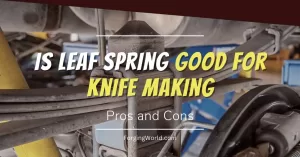Watching youtube videos and TV shows, such as Forged-in-Fire, might give you the impression that you can’t make your own knife unless you have a huge shop full of tools.
While it’s true that having all the necessary tools can make knife-making easier, you don’t need a lot to get started.
Today, I will go over how to make your own knife with only 5 basic tools. By the end of this article, you might be surprised to find out that you were only a few steps away from becoming a knife maker.
What Tools Do You Need to Make a Knife?
You only really need a handful of basic tools to start making knives on your own. Some of these tools you might already own, while others can be substituted with other tools that serve the same purpose.
The 5 essential tools you only need to make a knife are:
- Metal cutting tool (angle grinder, hack saw, chisel)
- Grinding tool (angle grinder, belt grinder, file, sandpaper)
- Heat source (propane torch, charcoal forge, propane forge)
- Any type of hammer (nail hammer, sledgehammer, framing hammer)
- Pounding surface (anvil, railroad track, large stone, concrete)
1. Metal Cutting Tool
The first essential tool you’ll need to make a knife is basically any tool that can cut metal.
Many of us might already have an angle grinder at home or know someone who can lend us theirs. If not, you can get a brand-new one for around $25 here.
You can also opt to cut metal manually with either a hack saw or even a chisel. These are great options if you don’t have access to an electric grinder and don’t mind a little elbow grease.
2. Grinding Tool
Once you have your metal cut, you’ll need a tool to shape and grind the blade’s edge. The first tool that may come to mind is a belt grinder.
You see most knife-making videos and TV shows using a belt grinder, but you don’t really need one to start making knives at home. In fact, I only recommend getting one after you’ve tried making a few knives without it.
Once you’re certain that bladesmithing is something you want to continue with, you can find them here for as low as $50.
In the meantime, you can use an angle grinder or even a file and some sandpaper to sharpen and refine the blade’s edge. It may take some extra time and might not be perfect, but it’s definitely doable.
Note: You can actually make a pretty decent knife from an old brake rotor, scrap metal, and even old tools with just the above tools! So long as the metal is pre-hardened, you can easily make a knife at home even without a forge.
3. Heat Source
For anyone looking to forge a knife at home using raw steel, one of the essential tools you’ll need is a reliable heat source.
Sure you can forge metal using just wood, but the most reliable way to forge a knife is a gas forge. Gas forges allow you to heat your metal to temperatures high enough for forging without the hassles of having to stoke and fan coal.
Note: I compared and reviewed several gas forges for making knives in this article here.
And if you don’t mind starting off with an old-school approach, you can also use a propane torch or even an old grill. Keep in mind forging with coal has a significantly higher carbon footprint than propane. But it’s a good way to try out the basics of bladesmithing before committing to buying a forge.
4. Any Type of Hammer
Who said you need a forging hammer to make a knife? Well, technically, it would help to have one. But in reality, any old hammer will do for starters.
It’s true that if you want to create some beautiful knives with intricate designs, having the right type of hammer is essential.
However, for now, just go ahead and grab that old rusty nail hammer from the toolbox. That’s all you really need to start whacking away at your metal.
5. Pounding Surface
To finish off, you’ll need a pounding surface for forging and shaping your blades.
The most common option is an anvil or an anvil block, which is basically a big hunk of steel. Not only are anvils difficult to purchase, but they are also difficult to get rid of! So, avoid making the mistake of buying one before you’re sure this is something you want to stick with.
If an anvil isn’t an option, no sweat! Any hard surface will do as an alternative. You can visit a local junkyard for some scrap railroad track or even find a large stone or concrete block to hammer on.
Just do your best to make sure it has a large enough face (flat surface) to straighten, shape, and trim your knife’s blade.
Final Thoughts
As you can see, making knives at home is easier than ever. All you really need to get started are a handful of basic tools and a little elbow grease. Everything else is pretty much optional.
If you’re ready to make your first knife with basic tools, check out our article on Beginner Knife Making Tips.

